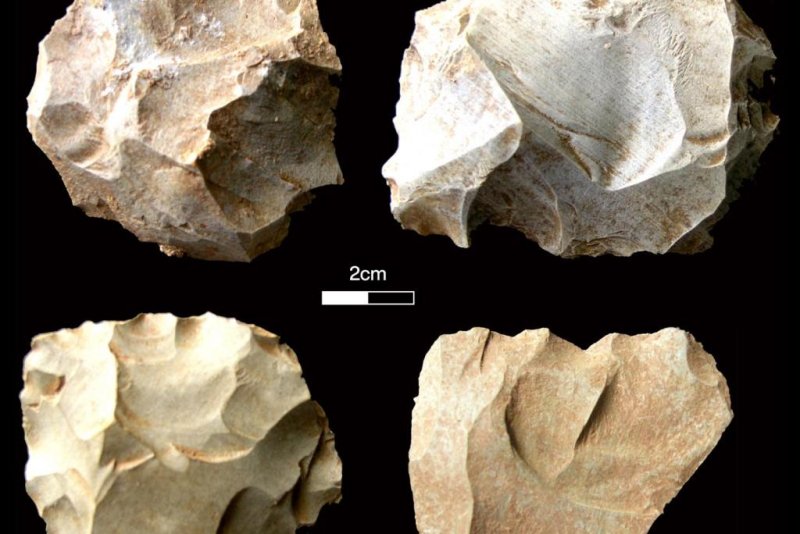Stone tools found at a dig site in India suggest early human populations had already arrived in Asia by the time the Toba supervolcano erupted. Photo by Chris Clarkson/University of Queensland
Feb. 25 (UPI) -- Paleontologists have previously posited that human populations living in Asia would have been wiped out by the Toba volcanic super-eruption, which occurred 74,000 years ago on the island of Sumatra in Indonesia.
In a new study, scientists refute the conventional wisdom on the Toba super-eruption, arguing Homo sapiens had arrived in Asia much earlier than previous estimates and that the impact of the Toba super-eruption on climate and environments has been overstated.
For the study, scientists analyzed evidence of human populations and climate change across a significant stratigraphic record -- a column of rock and sediment layers comprising 80,000 years of history -- from the Dhaba dig site in northern India's Middle Son Valley.
The column yielded stone artifacts suggesting Middle Palaeolithic tool-using populations were present in India prior to the Toba eruption.
"Although Toba ash was first identified in the Son Valley back in the 1980s, until now we did not have associated archaeological evidence, so the Dhaba site fills in a major chronological gap," researcher J.N. Pal, professor of ancient history and archaeology at the University of Allahabad in India, said in a news release.
Scientists have previously argued that Homo sapiens in Africa were only able to survive the Toba eruption thanks to their superior tools and adaptability. In the wake of the Toba eruption, these crafty Homo sapiens successfully left Africa and repopulated Asia around 60,000 years ago.
The latest research, published Wednesday in the journal Nature Communications, suggests humans had made their way to Asia much earlier than 60,000 years ago.
"Populations at Dhaba were using stone tools that were similar to the toolkits being used by Homo sapiens in Africa at the same time," said lead study author Chris Clarkson of the University of Queensland. "The fact that these toolkits did not disappear at the time of the Toba super-eruption or change dramatically soon after indicates that human populations survived the so-called catastrophe and continued to create tools to modify their environments."
Though Toba's eruption was quite dramatic, some 5,000 times larger than Mount St. Helen's eruption in the 1980s, the latest findings are in agreement with recent studies suggesting Earth's post-Toba cooling was mild and that the super-eruption failed to trigger a prolonged period of glaciation.
One recent study determined human populations in South Africa didn't simply survive the Toba eruption, they thrived.
But while the human populations at Dhaba were able to survive the Toba eruption and its aftermath, they didn't end up contributing much to the gene pool of contemporary peoples. Like all early human populations, these groups faced a variety of challenges -- including climate change.
"The archaeological record demonstrates that although humans sometimes show a remarkable level of resilience to challenges, it is also clear that people did not necessarily always prosper over the long term," said Michael Petraglia of the Max Planck Institute.















